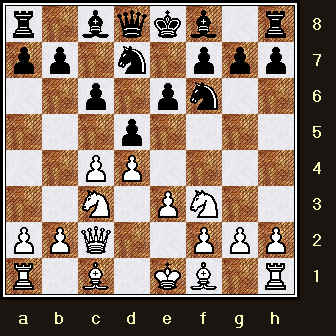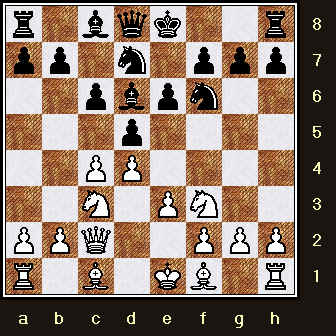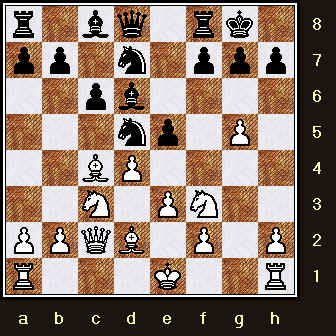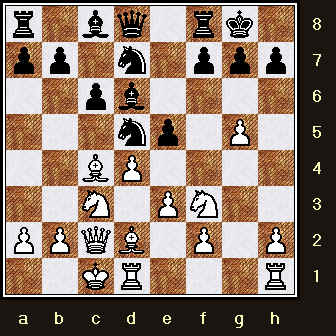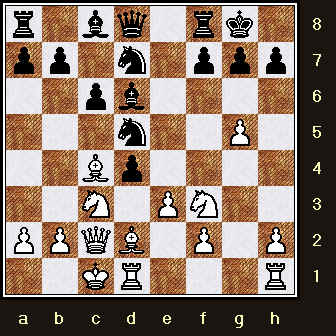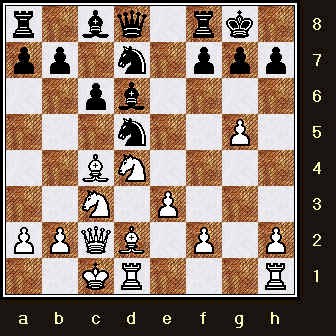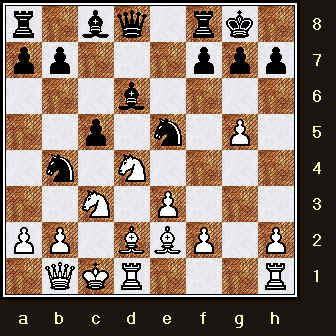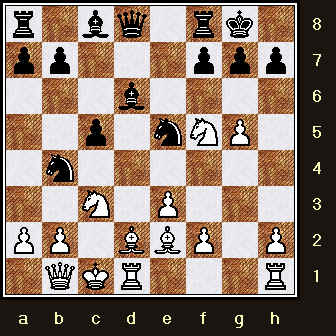All
the |
(Navigation bar
directly below.)
*******
© A.J. Goldsby, 2015.
(All rights reserved.)
****************
Click HERE
to see my
Chess Items.
****************
****************
Buy a book
from Amazon.com
(And help me out as well!)
****************
Click HERE
...
to see a list of the businesses that help to sponsor all of
my chess efforts.
Dreev ... on the rampage? |
I saw this game when I downloaded the latest issue of "The Week In Chess," from the (website) of the London Chess Center. Its a wild ride, and the variation is - at the present time - being played a great deal at the master level. So I thought, "Why not?"
*********************
This is mostly a text-based page ... with a few diagrams. You will probably want (or need) a chess set and board. (For the side lines.)
Click HERE to see an explanation of the symbols that I use when annotating a chess game. [replay]
GM Andrey Shariyazdanov (2583) -
GM Alexey Dreev
(2697);
|
|
|
A near 2600 player gets spanked ... and with the White pieces as well!
(This game was played in the big Aeroflot Open held in Moscow, RUS / February 8th - 17th, 2006. [more] )
***************************************************************************
1.d4 d5;
2.c4,
The Queen's Gambit ...
[ Or 2.Nf3, "+/=" (etc). ]
2...c6;
... which Black declines,
(The QGD.).
[ The move of:
2...dxc4!?,
is "The Queen's Gambit,
Accepted."
One
game in the QGA. Another carefully annotated example
of this
particular opening system. (The
QGA.) ]
3.Nc3 Nf6;
4.e3 e6;
This is probably the most solid move, Black supports his center and even frees his KB for quick development.
[ For a
game with the
continuation of:
4...a6!?;
5.Nf3 b5!?;
see my "GOTM
column"
and my "Game of The
Month" for Jan, 2006.
]
5.Nf3 Nbd7;
6.Qc2, ('!?' maybe - '!') {See
the diagram given, just below.}
This is a tricky move, that leads to a different kind of game than Black normally gets to see in this system.
*********************************************************************
|
|
r1bqkb1r/pp1n1ppp/2p1pn2/3p4/2PP4/2N1PN2/PPQ2PPP/R1B1KB1R b
*********************************************************************
This exact same variation also occurred {by transposition} in game one of the highly touted match between GM Garry Kasparov and Fritz_X3D. (See my web page on that historic clash for more details about the game - and the analysis.)
[ After the more commonly seen moves:
(>/=) 6.Bd3
dxc4; 7.Bxc4 b5; 8.Bd3 a6;
{Diagram?}
we reach the main line
of the MERAN SYSTEM
of the QGD, (Semi-Slav).
[ See MCO-14, beginning on page # 454; and columns # 01 - # 30. ]
You should also search the 'net, and look for the
best book on this very
complex opening system. ]
6...Bd6;
(center, development)
{See the diagram
given, just below.}
According to the database, this is by far the most common reply, although White can now
employ an unusual pawn thrust that might involve a possible gambit.
*********************************************************************
|
|
r1bqk2r/pp1n1ppp/2pbpn2/3p4/2PP4/2N1PN2/PPQ2PPP/R1B1KB1R w
*********************************************************************
Right now, the position is relatively balanced ... but White is about to profoundly disturb that equilibrium.
[ Also possible was: 6...a6; here. ]
7.g4!?,
hmmm
(Purpose?)
{See the
diagram given, just below.}
White attempts to disrupt the smooth development of his opponent's forces with this very unsettling play.
(The threat is g4-g5, forcing Black's KN
to move. - Ye humble editor)
*********************************************************************
|
|
r1bqk2r/pp1n1ppp/2pbpn2/3p4/2PP2P1/2N1PN2/PPQ2P1P/R1B1KB1R b
*********************************************************************
As far as I can tell, this was first used in a correspondence game in 1982.
(Hellstrom - Belis; 1982)
The first "big-time" use of this play was probably the contest:
GM M. Adams - GM Garry Kasparov; / ICT / Masters
{Invitational}
Dortmund, GER; (R #8) / 1992. (0-1, 22 moves!) (Another
miniature! -Ed.)
{See Informant # 54 for an analysis of this particular game.}
(After this game, the popularity of 7.g4!? took off like a rocket, later, even Garry would adopt the White side of this variation. Today, thousands of games have been played with this move.)
[ By far the most popular moves here would be
7.Be2 and 7.Bd3.
(Source - the "Mega" database for
2005.)
One popular reference work gives the following continuation:
7.Bd3 0-0; 8.0-0 dxc4;
9.Bxc4 b5; 10.Bd3 Bb7; 11.e4 e5;
12.dxe5!?
Nxe5;
The end of the column.
13.Nxe5 Bxe5; 14.h3 Re8;
15.Be3 Qe7; 16.Rae1,
"~" ("+/=" ?)
MCO analyzes this game out to move 19, where the
game was agreed drawn.
GM L. Portisch - GM V. Tukmakov; ICT / Reggio Emilia, 1987-88.
[ See MCO-14, page # 468, column # 33, and all relevant notes.
Especially see note # (l.) on pg. 469. ]
** ** ** ** ** ** ** ** ** ** ** ** ** ** ** **
But
... see also the game,
IM J. Bonin -
GM A. Shabalov; Marshall Chess
Club, NY / 1992.
(White won in forty-one moves.) ]
7...dxc4!?;
{See the diagram
given, just below.}
For some reason this has been condemned (or ignored) by general opening theory. (I found a survey in an NIC Yearbook. There is not much verbiage, but the author attached a dubious mark to this particular move.)
*********************************************************************
|
|
r1bqk2r/pp1n1ppp/2pbpn2/8/2pP2P1/2N1PN2/PPQ2P1P/R1B1KB1R w
*********************************************************************
While Black gives up the center, he does get a great deal of piece play.
(The main thing to watch out for is e4-e5, with a fork. But this is a fairly easy threat
for Black to defend against.)
[ Another contest saw the following continuation:
7...Bb4!?; 8.Bd2 Qe7;
9.Bd3, "+/=" {Diag?}
with a small edge for White.
GM Ruslan Ponomariov (2734) - GM Francisco Vallejo Pons (2629);
ICT / 20th Super-GM {Inv.}
/ Linares, ESP;
(R7) / 22,02,2003.
{White won a long and difficult contest, 1-0 in 68 tough moves.}
[ See also MCO-14, page # 468; column # 33, note (j.), Part B.). ]
***************************************************************************************
For the complexities that arise after the
continuation of
(</=)
7...Nxg4!?; ('?!')
8.Rg1 f5;
9.h3 Ngf6; 10.Rxg7,
"+/="
10...Ne4;
see the interesting contest:
GM Levon Aronian (2645) - GM Hannes Stefansson (2567);
The Fifth European Championships,
(EU-ch 5th) / (1-0, 40 moves.)
Antalya, Turkey;
(R3) / 15,05,2004.
{White won a nice
game in forty total moves.}
]
8.Bxc4 e5!?;
(Maybe even - '!')
Energetic play by Black.
There are many other tries here for Black, but the one chosen is by far the most popular, at least according to the results of the database.
The other two plays that look good, (besides castling); are 8...Qe7; and also 8...Nb6.
*** *** *** *** *** *** *** *** *** *** *** *** *** *** *** *** *** *** *** *** *** *** *** *** ***
We continue to follow the main line from here. (White pushes his g-pawn rather than trying to guard it. And castling on the King-side is just plain bad, at least it would be in this particular board set-up.)
9.g5 Nd5;
10.Bd2,
Once more - this is the 'book' play here for White.
[ A book trap would be:
</= 10.Nxd5? cxd5; 11.Bxd5?? Qa5+;
and White loses a full piece. ("-/+")
{The Bishop on d5 is lost.} ]
10...0-0!?;
{See the diagram given, just
below.}
Apparently ECO condemns this simple and logical play.
(But I am not sure if their analysis is 'up to snuff,'
here.)
*********************************************************************
|
|
r1bq1rk1/pp1n1ppp/2pb4/3np1P1/2BP4/2N1PN2/PPQB1P1P/R3K2R w
*********************************************************************
Black is offering a Pawn gambit here, but his opponent decides to decline it.
(For whatever reason.)
[ Another solid idea was: 10...N7b6!?; "~" with a decent position here for Black. ]
11.0-0-0!?,
(Really just - '?!')
{See
the diagram given, just below.}
I feel bad when I have to condemn castling, but here it is probably not the best idea for White.
*********************************************************************
|
|
r1bq1rk1/pp1n1ppp/2pb4/3np1P1/2BP4/2N1PN2/PPQB1P1P/2KR3R b
*********************************************************************
Strangely -
GM A. Dreev
had already played this same position vs. V. Dobrov;
(The Russian Federation {Internet} Cup Finals, in 2004.) ...
... so he knows what to do from here.
[ Probably an improvement was:
(>/=) 11.Nxd5 cxd5;
12.Bxd5, "~"
(Maybe
"+/=") - The (Fritz)
Powerbook
]
Now the KEY POSITION has been reached and Dreev has some very important decisions to make about the nature of the center.
11...exd4!;
Relieving center tension.
{See the diagram
given, just below.}
Normally mass exchanges like this allow White the better game, especially as White's Rook is on the d-file, a possible "vis-a-vis" with the Black Queen.
*********************************************************************
|
|
r1bq1rk1/pp1n1ppp/2pb4/3n2P1/2Bp4/2N1PN2/PPQB1P1P/2KR3R w
*********************************************************************
But not to worry - Black has calculated the consequences very exactly, and has everything under control.
[ Not as accurate would have been:
</=
11...N7b6!?; 12.Bd3 Bg4; 13.Nxe5!,
"~" & White has "comp." ]
12.Nxd4?!,
{See the diagram
given, just below.}
The "normal" recapture ... (trying to maintain the tension), but it is also wrong.
*********************************************************************
|
|
r1bq1rk1/pp1n1ppp/2pb4/3n2P1/2BN4/2N1P3/PPQB1P1P/2KR3R b
*********************************************************************
Take a long, sober look at the position that we currently have on the chess board.
[ A
big improvement was:
>/=
12.Nxd5 cxd5;
13.Bxd5,
"~" ("+/=") etc.
(But Black should have decent play.)
GM Zhu Chen (2495) - GM L. Dominguez
(2605); / [D45]
ICT /
CORUS Masters, ("B" section) /
Wijk aan Zee, NED; (R11) /
10,01,2004.
{The
game was eventually drawn.}
]
(It is BLACK to play here. What move would you pick - if you had this position?)
12...Nb4!;
13.Qb1,
Now this is forced.
[ </= 13.Qe4?! Re8; 14.Qb1 Ne5; "/+" ]
13...Ne5;
14.Be2 c5!; {See the diagram
given, just below.}
Black is unconcerned about the WR on d1, it will never be a factor. Meanwhile, Black has
focused all of his energy on the crucial light square, d3.
*********************************************************************
|
|
r1bq1rk1/pp3ppp/3b4/2p1n1P1/1n1N4/2N1P3/PP1BBP1P/1QKR3R w
*********************************************************************
This is probably the most important position of the whole game.
White to move in this position.
(What is the BEST move ... the move that White should play here?)
15.Nf5?,
{See the diagram - just below.}
The losing move.
*********************************************************************
|
|
r1bq1rk1/pp3ppp/3b4/2p1nNP1/1n6/2N1P3/PP1BBP1P/1QKR3R b
*********************************************************************
White avoids the correct move, (see the note just below); and in so doing goes from bad - to much worse.
[ After the moves of:
>/=
15.Nf3 Nxf3; 16.Bxf3 Qxg5;
"=/+" 17.a3,
"~"
White is a Pawn down, with a position that is unfavorable to him,
but the
first player is NOT clearly lost.
]
Now Black just ignores the White Knight, (and any of his opponent's attempts at counterplay); and just continues to hammer away on the d3-square.
15...c4!;
16.Nxd6?!, Ugh!
The box shows that White had to sack an exchange just to stay alive. Shariyazdanov disdains this defensive possibility ... and goes down in flames.
[ White probably had to play:
(>/=) 16.Be1 Ned3+;
17.Bxd3 Nxd3+;
18.Rxd3 cxd3;
19.Qxd3 Bc5; (etc.)
if he was not ready to resign. ]
(Now Black does not automatically recapture the White Knight on d3, but instead plays another move ... and one that leaves his opponent with little choice, as it comes with check. This is
known as an "in-between move," or a "zwischenzug," in chess terminology.)
16...Ned3+!;
17.Bxd3[] 17...Nxd3+; 18.Kc2 Qxd6; "-/+"
Black is now winning.
The rest requires no comment.
(19.f3[] was probably forced ... now Black's advantage more than doubles ...
but White's game is already beyond salvation.)
19.Be1!? Bg4;
20.Rd2!? Bf3, White
Resigns.
(After 21.Rg1, and now 21...Qxh2; White will probably lose at least a Rook.)
[ Maybe >/= 20...Qc6!; "-/+" was an improvement for GM A. Dreev? ]
An interesting game in an opening variation ... that is {currently} hotly debated at the master level. It is also a miniature. (To add to my collection.)
Copyright (c) A.J. Goldsby, 2006. All rights reserved.
0 - 1
The analysis for this page was prepared with the excellent program, ChessBase 9.0.
The HTML was polished with several different tools and programs, (mostly FP) ... the text was checked for spelling with MS Word.
The diagrams were created with the program, Chess Captor 2.25.
Click HERE to - go to or return - to my HOME PAGE ... for this site.
Click HERE to go (or return) to my site map (page).
Click HERE to go to my "Annotated Games II" (page).
Click HERE
to go (or return) to my {2nd}
main page on
miniatures / or "Best Short Games," (Vol. IV.)
(Or you could use the "Back
Button" on your web browser.)
Copyright (c) LM A.J. Goldsby I
Copyright (©) A.J. Goldsby, 2011. All rights reserved.
*******
This page was first created in February, 2006. It was posted: 02/22/2006. It was last updated on: July 14, 2012 02:16 AM .
